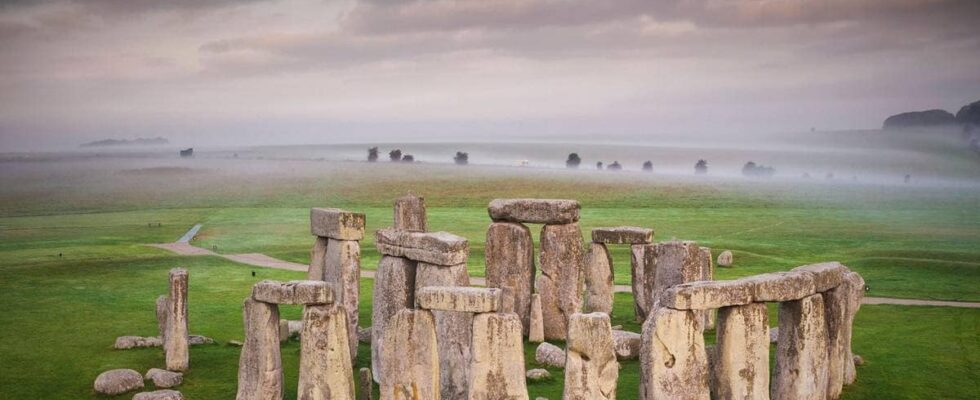There are many questions surrounding one of the world’s most famous Stone Age buildings. The placement of the giant stones on a plain in England has led to wild theories that aliens must have had a hand in the game. Now a PhD student has revealed that the important altar stone did not come from Wales, 250 kilometers away, but from the Orkney Islands in Scotland, a whopping 700 (!) kilometers away. But the Stone Age people did not need help from outer space. They managed to move it all by themselves. Got backwards – I don’t think I’ll be forgiven at home, says Welshman Anthony Clarke jokingly to the BBC. It is he who has now found the evidence that what has been called the altar stone at Stonehenge is Scottish. This is the final death blow to the old theory that the stone came from Wales. – It set us back when we discovered it was from north-east Scotland, says Professor Nick Pearce. He has also contributed to the discovery which has been published in the renowned journal Nature. The altar stone from Scotland is partially covered by two other stones from the Marlborough area in England. Photo: Nick Pearce/Aberystwyth University / Reuters The researchers have analyzed the chemical composition of small pieces from the altar stone. With access to a huge database of where different rock types come from, they hit on Orcadian, an area between northern Scotland, the Orkney Islands and Shetland. – It was a shock, to say the least, says Pearce to the BBC. He says the next mystery will be to find out how the stone came to England. No stress If you get in the car, it takes between nine and ten hours to drive the slightly over 700 kilometers from Trondheim to Risør in Agder. But those who were supposed to transport the altar stone from the Orkney Islands to Stonehenge did not have paved roads or trucks. Then they weren’t in a big hurry either, says Daniela Hofmann. She is a professor at the University of Bergen and researches the Stone Age in Europe. – We often think of people in the Stone Age as being a bit primitive, but they clearly weren’t, says Hofmann. There are several theories about what Stonehenge was used for. Photo: TOBY MELVILLE / Reuters The altar stone, which is five meters long, one meter wide and half a meter thick, may have been transported both by land and by water. Hofmann says people 4-5,000 years ago had boats that could keep this stone afloat. They could also have dragged the stone overland on logs. Perhaps it was a combination of the methods. In 2016, volunteers took part in an experiment to use human power to move a one-tonne concrete block. The aim was to test techniques for moving large stones using Stone Age technology to Stonehenge. Photo: Matt Dunham / AP She says that instead of the stone having to be as fast as possible to Stonehenge, it may have been a point that it took time. In this way, people along the route could feel that they were part of a large joint project. Hofmann imagines that people could have feasts after transporting the stone from one place to the next. Professor Daniela Hofmann. Photo: Universitetet i Bergen It could link people together, and to the holy places, such as Stonehenge. – Everyone could say that they helped build this wonderful monument. That in itself it became a myth they could tell. A feat like those in the legends from the Viking Age. Stonehenge Stonehenge is a prehistoric monument, the oldest parts of which date from around 3000 BC. It is located in Amesbury, about 13 km north-west of Salisbury in Wiltshire in southern England. The name comes from the Old English word Stanhengist which means “the hanging stones”. Stonehenge consists of large stones erected in two circles. The outer circle is 30 meters in diameter and consists of approximately 5 meter high stones. A row of long, horizontal stones rests on these. The inner circle consists of five pairs of high stones. There are several theories about its use. The facility may have had a religious function. Another theory says that it has been used for astronomical observations. Stonehenge is also associated with the legend of King Arthur. Sources: Wikipedia, Great Norwegian Lexicon Stone’s Gucci The outermost ring of Stonehenge consists of stones from what can be called the immediate area, from England. Inside there is another ring. It contains stones with a blue tint that are from Wales. Finally, you have the altar stone which is partially buried under some other stones in the middle of the monument. An illustration of the stones of Stonehenge. The altar stone from Scotland is marked in green. The blue stones are from Wales, while the light and dark brown stones are from England. Photo: Clarke, AJI, Kirkland, CL, Bevins, RE et al. / NATURE/CC BY 4.0 Hofmann says people in the Stone Age were concerned with … stone. They could attach special properties and powers to different types of stones from different places. People exchanged stones for axes and the like over great distances. – It was perhaps a bit like having a Gucci, says the UiB professor. People could tell from, for example, the color that it was special. Exchange On Orkney there are places that were considered sacred at the same time as Stonehenge was in use. An example is the stone rings at Brodgar and Stenness. Hofmann says that transporting stone from the archipelago to Stonehenge can be seen as a kind of exchange. – You can say that they have a connection between Stonehenge and one of the other large, sacred sites that we have from that time. Published 17.08.2024, at 07.46
ttn-69
The altar stone in Stonehenge was transported 700 kilometers from Scotland – news Trøndelag – Local news, TV and radio

